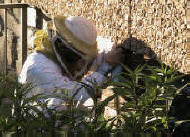|
|
 |
|||||||||||||||||||
|
|
||||||||||||||||||||
|
|
||||||||||||||||||||
|
|
||||||||||||||||||||
|
Contact our office about bee removal services or wasp control problems that you may be having, we can help.
Bee control and wasp removal services are available In and around Phoenix and the surrounding cities only.
|

Phoenix, Arizona Bee Removal Services Phoenix Bee, Killer Bee & Wasp Removal Specialists with 26 years experience DANGER -- DO NOT TRY TO DESTROY EUROPEAN OR AFRICANIZED "killer" BEES ON YOUR OWN YOU MAY BE PUTTING YOUR LIFE AT RISK.
OH MY GOSH - Have you just come home from work around 4 or 5 pm and discovered a clump of bees on a tree in your yard or on the side of your house that wasn't there when you left ? That is what's called a feral swarm of bees that is most likely just passing through as the old queen bee and some workers are out looking for a new home, these type of swarms will generally move on in about 24 - 72 hours as long as they are not going into a wall void or hollow space - if they are going into a void that will most likely be the new home for the bees and the new swarm should be treated right away. If you can wait the clump of bees out and the location is not some where that is a danger to anyone the bees will generally move on in 24 - 72 hours after they have had time to locate a new void or hollow space to set up the new hive. What generally happens after our bee treatment - If we have just performed a bee treatment service we would tell you that you may expect that bee activity could continue for the next 24 to 72 hours as returning bees come home and find the hive has been treated or is gone. A common occurrence is that you may even find that the bees are not going into the treated opening but are collecting on the side of a wall or bush near the treated opening in what some people describe as a softball size clump of bees. Please call us after the 48 - 72 hours if after that time, you still have bee activity. Most of the products that we use for bee control or removal are generally low or non-toxic to humans and animals and are usually not harmful to your property. There may be an
opening that the bees originally entered through like a hole in the sofit. This needs to It is possible for another swarm to move into some other area of your property at any time, however it is unusual for a residential property to have a frequent reoccurring problem with bees unless the property is near a wash or the open desert. Sometimes a residual honeycomb in the wall can attract more bees, or the honey can create damage to the wall or drywall on the other side of the wall. Most bees swarms are removed in time, but if needed, we can perform a honey comb removal service at an additional charge after the bees are completely gone. Some locations we need to do a tear out may require you to arrange for restoring the wall and retexturing. Africanized Bees in many cases require treatment after dark to remove or stop the threat of attack. Bees are much calmer at night and it is safer for the surrounding inhabitants and pets.
EUROPEAN HONEYBEES are what you are use to seeing when you think of
bees. They live in colonies made of wax. They can last for many years at a
single nest site, becoming semi-dormant during the winter months. They feed on
nectar and pollen. Bees are an extremely important and beneficial insect due to
its production of honey and other products, as well as pollination of most plants.
However, when bees nest inside of a wall or are creating a threat to humans or
animals, unfortunately the only route is destruction in most cases. AFRICANIZED HONEYBEES (popularly known as "killer bees") are not something to take lightly. Looking just like our domestic honeybee, their behavior is quite different. They frequently attack people and animals who unwarily stray into the territory they defend around their nests. Unforeseen stinging attacks have sometimes resulted in serious injury or death. Though their venom is no more potent than that of our common European Honeybee, Africanized Bees respond in greater numbers and pursue intruders for greater distances. Also, disturbed colonies may remain agitated for as long as 24 hours. Any person or animal in the patrolled area is vulnerable. The nest itself need not be disturbed. Africanized Bees have responded ferociously to everyday occurrences such as vibrations generated by passing vehicles, power equipment and even foot traffic, many landscapers discover the bees when they do the yard work using mowers and blowers which create noise and vibrations. EXPERTS AGREE THAT THE BEST METHOD OF ESCAPING AN ATTACK IS TO COVER YOUR HEAD AND RUN FOR COVER INSIDE A CAR, HOUSE OR SOMEPLACE THAT THE BEES CAN'T GET INTO - DON'T JUMP INTO A POOL OR STAND AND SWAT AT THE BEES - JUST RUN. KILLER BEES HAVE BEEN KNOWN TO FOLLOW SOMEONE OVER A 1/4 MILE AND YOU CAN'T OUT RUN THEM ! A little history on
Africanized honey bees (AHB) they
were first discovered in Arizona when a colony, established in the roof of a
Tucson house, stung a small dog to death on 6 June 1993. Experienced
beekeepers and federal and state scientists who examined the remains of the
colony suggested the colony was between 4 and 8 months old, placing its
arrival into the state possibly as early as October, 1992. This was the
second state in the U.S., after Texas, to confirm the natural spread from
Mexico of this non-native species.
PLEASE NOTE: THIS IS FOR GENERAL INFORMATION PURPOSES ONLY AND NOT MEANT TO
TAKE THE PLACE OF COMMON SENSE OR PROFESSIONAL MEDICAL ADVICE. RULE OF THUMB
- 10 stings per pound of body weight >
CALL FOR HELP & SEE A DOCTOR NOW !!
you are in danger of
death as your different organs could start to shut down because of the bee
venom, people have died from far less stings. Small children and the
elderly are the most likely people to have a problem.
Please call us for any of your bee or bird control questions and problems. |
|||||||||||||||||||
|
Copyright © 2004 Arizona Wings-N-Stings All rights reserved. Revised: 10/09/10. |
||||||||||||||||||||


 be sealed on the outside after the bees have left or died off. We can do this at
an additional charge, but it is usually simple for the homeowner to do
themselves with some caulking.
be sealed on the outside after the bees have left or died off. We can do this at
an additional charge, but it is usually simple for the homeowner to do
themselves with some caulking.

